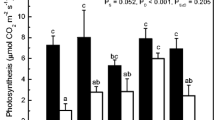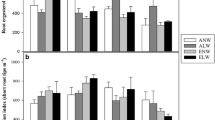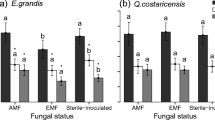Abstract
In managed settings, seedlings are often fertilized with the objective of enhancing establishment, growth, and survival. However, responses of seedlings to fertilization can increase their susceptibility to abiotic stresses such as drought. Seedlings acclimate to variation in soil resources by reallocating carbon among different physiological processes and compartments, such as above versus belowground growth, secondary metabolism, and support of ectomycorrhizal fungi (EMF). We examined the effects of nutrient and water availability on carbon allocation to above and belowground growth of river birch (Betula nigra), as well as partitioning among root sugars, starch, phenolics, lignin, and EMF abundance. As nutrient availability increased, total plant biomass and total leaf area increased, while percent root biomass decreased. Root sugars, total root phenolics and EMF abundance responded quadratically to nutrient availability, being lowest at intermediate fertility levels. Decreased water availability reduced total leaf area and root phenolics relative to well-watered controls. No interactions between nutrient and water availability treatments were detected, which may have been due to the moderate degree of drought stress imposed in the low water treatment. Our results indicate that nutrient and water availability significantly alter patterns of carbon allocation and partitioning in roots of Betula nigra seedlings. The potential effects of these responses on stress tolerance are discussed.
Similar content being viewed by others
References
Aerts R, Chapin FS (2000) The mineral nutrition of wild plants revisited: a re-evaluation of processes and patterns. Adv Ecol Res 30:1–65
ANSI (2004) American National Standard for tree care operations—tree, shrub, and other woody plant maintenance—standard practices (Fertilization). ANSI A300 (Part 2)—2004 Fertilization revision of ANSI A 300 (Part 2)—1998
Avis PG, McLaughlin DJ, Dentinger BC, Reich PB (2003) Long-term increase in nitrogen supply alters above and below ground ectomycorrhizal communities and increases the dominance of Russula spp. in a temperate oak savanna. New Phytol 160:239–253
Bennett RN, Wallsgrove RM (1994) Secondary metabolites in plant defense mechanisms. New Phytol 127:617–633
Blodgett JT, Herms DA, Bonello P (2005) Effects of fertilization on red pine defense chemistry and resistance to Sphaeropsis sapinea. For Ecol Manag 208:373–382
Chew V (1976) Comparing treatment means: a compendium. Hortscience 11:348–357
Clemmensen KE, Michelson A, Jonasson S, Shaver GR (2006) Increased ectomycorrhizal fungal abundance after long-term fertilization and warming of two artic tundra ecosystems. New Phytol 171:391–404
Close DC, MacArthur C (2002) Rethinking the role of many plant phenolics: protection from photodamage not herbivores? Oikos 99:166–172
Combs SM, Nathan MV (1998) Soil organic matter. Recommended chemical soil test procedures for the North Central region, NCR Publication no. 221. Missouri Agricultural Experiment Station, Columbia, pp 53–58
Craul PJ (1994) Urban soils: an overview and their future. In: Watson GW, Neely D (eds) The landscape belowground. International Society of Arboriculture, Champaign
Davies FT, Svenson SE, Cole JC, Phavaphutanon L, Duray SA, Olaide-Portugal V, Meyer CE, Bo SH (1996) Non-nutritional stress acclimation of mycorrhizal woody plants exposed to drought. Tree Physiol 16:985–993
Feughy L, Strullu DG, Poupard P, Simoneau P (1999) Induced defence responses limit Hartig net formation in ectomycorrhizal birch roots. New Phytol 144:541–547
Fort C, Muller F, Label P, Granier A, Dreyer E (1998) Stomatal conductance, growth and root signaling in Betula pendula seedlings subjected to partial soil drying. Tree Physiol 18:769–776
Frank K, Beegle D, Denning J (1998) Phosphorus. Recommended chemical soil test procedures for the North Central region, NCR Publication No. 221. Missouri Agricultural Experiment Station, Columbia, pp 21–23
Gelderman RH, Beegle D (1998) Nitrate–nitrogen. Recommended chemical soil test procedures for the North Central region, NCR Publication No. 221. Missouri Agricultural Experiment Station, Columbia, pp 17–20
Gilman EF, Watson DG (1993) Betula nigra: river birch. Fact sheet ST-94. University of Florida, Institute of Food and Agricultural Sciences, pp 1–3
Glynn C, Herms DA, Egawa M, Hansen RC, Mattson WJ (2003) Effects of nutrient availability on dry matter allocation, and constitutive and induced insect resistance of poplar. Oikos 101:385–397
Glynn C, Herms DA, Orians CM, Hansen RC, Larsson S (2007) Testing the growth-differentiation balance hypothesis: dynamic responses of willows to nutrient availability. New Phytol 176:623–634
Goodsman DW, Lieffers VJ, Landhaeusser SM, Erbilgin N (2010) Fertilization of lodgepole pine trees increased diameter growth but reduced root carbohydrate concentrations. For Ecol Manag 260:1914–1920
Gray DE, Pallardy SG, Garrett HE, Rottinghaus GE (2003) Acute drought stress and plant age effects on alkamide and phenolic acid content in purple coneflower roots. Planta Med 690:50–55
Gu MM, Rom CR, Robbins JA, Oosterhuis DM (2007) Effect of water deficit on gas exchange, osmotic solutes, leaf abscission and growth of four birch genotypes (Betula L.) under a controlled environment. Hortscience 42:1383–1391
Hagan AK, Akridge JR, Bowen KL (2008) Nitrogen and flowering dogwood. I. Impact of nitrogen fertilization rate on the occurrence of spot anthracnose, powdery mildew, and Cercospora leaf spot and their effect on tree growth. J Environ Hort 26:197–203
Hale BK, Herms DA, Hansen RC, Clausen TP, Arnold D (2005) Effects of drought stress and nutrient availability on dry matter allocation, phenolic glycosides, and rapid induced resistance of poplar to two lymantriid defoliators. J Chem Ecol 31:2601–2620
Helmke PA, Sparks DL (1996) Lithium, sodium, potassium, rubidium, and cesium. Methods of soil analysis, Part 3: Chemical methods. Soil Science Society of America, Madison, pp 568–569
Herms DA (2002) Effects of fertilization on insect resistance of woody ornamental plants: reassessing an entrenched paradigm. Environ Entomol 31:923–933
Herms DA, Mattson WJ (1992) The dilemma of plants—to grow or defend. Q Rev Biol 67:283–335
Herms DA, Mattson WJ (1997) Trees, stress, and pests. In: Lloyd JE (ed) Plant health care for woody ornamentals. International Society of Arboriculture, Champaign, pp 13–25
Huberty AF, Denno RF (2004) Plant water stress and its consequences for herbivorous insects: a new synthesis. Ecology 85:1383–1398
Hunt R (1978) Plant growth analysis. E. Arnold, London
Ibrahim ML, Proe F, Cameron AD (1997) Main effects of nitrogen supply, and drought stress upon whole plant carbon allocation in poplar. Can J For Res 27:1413–1419
Ingestad T, Ågren DI (1988) Nutrient-uptake and allocation at steady-state nutrition. Physiol Plantar 72:450–459
Keski-Saari S, Julkunen-Tiitto R (2003) Resource allocation in different parts of juvenile mountain birch plants: effect of nitrogen supply on seedling phenolics and growth. Physiol Plantar 118:114–126
Kleczewski NM, Herms DA, Bonello P (2010) Effects of soil type, fertilization and drought on carbon allocation to root growth and partitioning between secondary metabolism and ectomycorrhizae of Betula papyrifera. Tree Physiol 30:807–813
Kleiner KW, Abrams MD, Schultz JC (1992) The impact of water and nutrient deficiencies on the growth, gas exchange and water relations of red oak and chestnut oak. Tree Physiol 11:271–287
Kobe RK, Iyer M, Walters MB (2010) Optimal partitioning theory revisited: non-structural carbohydrates dominate root mass responses to nitrogen. Ecology 91:166–179
Koricheva J (1999) Interpreting phenotypic variation in plant allelochemistry: problems with the use of concentrations. Oecologia 119:467–473
Kosola KR, Parry D, Workmaster BAA (2006) Responses of condensed tannins in poplar roots to fertilization and gypsy moth defoliation. Tree Physiol 26:1607–1611
Kozlowski TT (2002) Acclimation and adaptive responses of woody plants to environmental stresses. Bot Rev 68:270–334
Kraus TEC, Zasoski RJ, Dahlgren RA (2004) Fertility and pH effects on polyphenol and condensed tannin concentrations in foliage and roots. Plant Soil 262:95–109
Linder S, Benson ML, Myers BJ, Raison RJ (1987) Canopy dynamics and growth of Pinus radiata. I. Effects of irrigation and fertilization during drought. Can J For Res 17:1157–1165
Lloyd JE, Herms DA, Rose M, Wagoner JV (2006) Fertilization rate and irrigation scheduling in the nursery influence growth, insect performance, and stress tolerance of “Sutyzam” crabapple in the landscape. Hortscience 41:442–445
Ludovici KH, Allen HL, Albaugh TJ, Dougherty PM (2002) The influence of nutrient and water availability on carbohydrate storage in loblolly pine. For Ecol Manag 159:261–270
McDonald AJS, Ericsson A, Lohammar T (1986) Dependance of starch storage on nutrient availability and photon flux density in small birch Betula pendula Roth. Plant Cell Environ 9:433–438
Mooney HA, Fichtner K, Schulze ED (1995) Growth, photosynthesis, and storage of carbohydrates and nitrogen in Phaseolus lunatus in relation to resource availability. Oecologia 104:17–23
Mudge KM, Diebolt KS, Whitlow TH (1987) Ectomycorrhizal effect on host plant response to drought stress. J Environ Hortic 5:183–187
Muller RN, Kalisz PJ, Luken JO (1989) Fine root production of astringent phenolics. Oecologia 79:563–565
Nehls U (2008) Mastering ectomycorrhizal symbiosis: the impact of carbohydrates. J Exp Bot 59:1097–1108
Nehls U, Gohringer F, Wittulsky S, Dietz S (2010) Fungal carbohydrate support in the ectomycorrhizal symbiosis: a review. Plant Biol 12:292–301
Newton AC, Pigott CD (1991) Mineral nutrition and mycorrhizal infection of seedling oak and birch 2. The effect of fertilizers on growth, nutrient uptake, and ectomycorrhizal infection. New Phytol 117:45–52
Nilsen P (1995) Effect of nitrogen on drought strain and nutrient uptake in Norway spruce Picea abies (L.) Karst.) trees. Plant Soil 172:73–85
Ostonen I, Puttsepp U, Biel C, Alberton O, Bakker MR, Lohmus K, Majdi H, Metcalfe D, Olsthoorn AFM, Pronk A, Vanguelova E, Weih M, Brunner I (2007) Specific root length as an indicator of environmental change. Plant Biosyst 141:426–442
Pearce RB (1996) Antimicrobial defenses in the wood of living trees. New Phytol 132:203–233
Piri T (1998) Effects of vitality fertilization on the growth of Heterobasidion annosum in Norway spruce roots. Eur J For Pathol 28:391–397
Poorter H, Nagel O (2000) The role of biomass allocation in the growth response of plants to different levels of light, CO2, nutrients and water: a quantitative review. Aust J Plant Physiol 27:1191
Ranney TG, Whitlow TH, Bassuk NL (1990) Response of 5 temperate deciduous tree species to water stress. Tree Physiol 6:439–448
Ranney TG, Bir RE, Skroch WA (1991) Comparative drought resistance among 6 species of Birch (Betula): Influence of mild water-stress on water relations and leaf gas exchange. Tree Physiol 8:351–360
Raupp MJ, Shrewsbury PM, Herms DA (2010) Ecology of herbivorous arthropods in urban landscapes. Annu Rev Entomol 55:19–38
Rozema J, vande Staaij J, Bjorn LO, Caldwell M (1997) UV-B as an environmental factor in plant life: stress and regulation. Trends Ecol Evol 12:22–28
Rytter L, Ericsson T, Rytter R (2003) Effects of demand-driven fertilization on nutrient use, root:plant ratio, and field performance of Betula pendula and Picea abies. Scand J For Res 18:401–412
Shipley B, Meziane D (2002) The balanced-growth hypothesis and the allometry of leaf and root biomass. Funct Ecol 16:326–331
Smith SE, Read DJ (1997) Mycorrhizal symbiosis. Academic Press, San Diego
Sofo A, Dichio B, Xiloyannis C, Masia A (2005) Antioxidant defences in olive trees during drought stress: changes in activity of some antioxidant enzymes. Funct Plant Biol 32:45–53
Tarkka M, Nehls U, Hampp R (2005) Physiology of ectomycorrhizae. Prog Bot 66:247–276
Thomas GW (1996) Soil pH and soil acidity. Methods of soil analysis, Part 3: Chemical methods. Soil Science Society of America, Madison, pp 475–490
Treseder KK (2004) A meta-analysis of mycorrhizal responses to nitrogen, phosphorous, and athmospheric CO2 in field studies. New Phytol 164:347–355
Treseder KK, Allen MF (2002) Direct nitrogen and phosphorus limitation of arbuscular mycorrhizal fungi: a model and field test. New Phytol 155:507–515
Vannette RL, Hunter MD (2011) Plant defense theory re-examined: nonlinear expectations based on the costs and benefits of resource mutualisms. J Ecol 99:66–76
Vizoso S, Gerant D, Guehl JM, Joffre R, Chalot M, Gross P, Maillard P (2008) Do elevation of CO2 concentration and nitrogen fertilization alter storage and remobilization of carbon and nitrogen in pedunculate oak saplings? Tree Physiol 28:1729–1739
Walker RF, McLaughlin SB, West DC (2004) Establishment of sweet birch on surface mine spoil as influenced by mycorrhizal inoculation and fertility. Restor Ecol 12:8–19
Walters MB, Reich PB (1989) Response of Ulmus americana seedlings to varying nitrogen and water status. 1 Photosynthesis and growth. Tree Physiol 5:159–172
Wargo PM (1996) Consequences of environmental stress on oak: predisposition to pathogens. Ann Sci For 53:359–368
Warncke D, Brown JR (1998) Potassium and other basic cations. Recommended chemical soil test procedures for the North Central region, NCR Publication No. 221. Missouri Agricultural Experiment Station, Columbia, pp 31–33
Weidner S, Karolak M, Karamac M, Kosinska A, Amarowicz R (2009) Phenolic compounds and properties of antioxidants in grapevine roots (Vinis vinifera L.) under drought stress followed by recovery. Acta Soc Bot Pol 78:97–103
Weiss M, Schmidt J, Neumann D, Wray V, Chriss R, Strack D (1999) Phenylpropanoids in mycorrhizas of the Pinaceae. Planta 208:491–502
Acknowledgments
We thank Victoria Caceres and two anonymous reviewers for insightful comments on earlier drafts of this work, and David Snodgrass, Duan Wang, Justin Whitehill and Jim Vent for their assistance with many technical aspects of this work. This research was supported by USDA Forest Service National Urban and Community Forestry Advisory Grant No. 03-DG-11244225-428 to D.A.H. and P.B., a Tree Research and Education Endowment Fund John Z. Duling Grant to P.B. and D.A.H., an Ohio Agricultural Research and Development Center SEEDS Graduate Student Grant to N.M.K., and by State and Federal funds appropriated to the Ohio Agricultural Research and Development Center, The Ohio State University.
Author information
Authors and Affiliations
Corresponding author
Additional information
Communicated by T. Koike.
Rights and permissions
About this article
Cite this article
Kleczewski, N.M., Herms, D.A. & Bonello, P. Nutrient and water availability alter belowground patterns of biomass allocation, carbon partitioning, and ectomycorrhizal abundance in Betula nigra . Trees 26, 525–533 (2012). https://doi.org/10.1007/s00468-011-0613-3
Received:
Revised:
Accepted:
Published:
Issue Date:
DOI: https://doi.org/10.1007/s00468-011-0613-3




